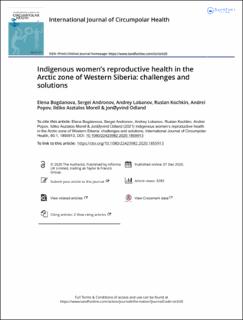| dc.contributor.author | Bogdanova, Elena | |
| dc.contributor.author | Andronov, Sergei | |
| dc.contributor.author | Lobanov, Andrey | |
| dc.contributor.author | Kochkin, Ruslan | |
| dc.contributor.author | Popov, Andrey Ivanovich | |
| dc.contributor.author | Asztalos Morell, Ildiko | |
| dc.contributor.author | Odland, Jon Øyvind | |
| dc.date.accessioned | 2022-12-08T10:04:39Z | |
| dc.date.available | 2022-12-08T10:04:39Z | |
| dc.date.created | 2021-06-22T14:41:52Z | |
| dc.date.issued | 2021 | |
| dc.identifier.citation | International Journal of Circumpolar Health. 2021, 80 (1), 1-12. | en_US |
| dc.identifier.issn | 1239-9736 | |
| dc.identifier.uri | https://hdl.handle.net/11250/3036702 | |
| dc.description.abstract | In the Russian Arctic, alarming trends (shortage of nomadic Indigenous women, high reproductive loss, child mortality rates) indicate long-term changes towards demographic decline. This study aimed at comparing some indicators of the reproductive health (childbirth rates, number of pregnancies, pregnancy loss) of Indigenous and non-Indigenous women in the exploration of cultural and social factors influencing reproductive behaviour. A multidisciplinary approach draws on methods of medicine, sociology and health economics. It includes data of the women’s reproductive health collected from surveys of 879 women (of whom 627 were Indigenous) during expeditions to the settlements and the tundra of the Yamal-Nenets Autonomous Okrug in 2013–2019. In the tundra, 66.7% of registered Indigenous women’s pregnancies resulted in childbirth, 7.8% in induced abortions, 25.5% in spontaneous miscarriage. More than three children were delivered by 59.1% of Indigenous women. Most Indigenous families suffered from high pregnancy loss. Marriage between close relatives was 27.0%. Child mortality equalled 24.4%, three times higher than in the population of the settlements and eight times higher than in families immigrating from other regions. The survival of Indigenous peoples significantly depends on women’s reproductive health and sufficient medical service that requires targeted policy. | en_US |
| dc.language.iso | eng | en_US |
| dc.publisher | Taylor and Francis | en_US |
| dc.rights | Navngivelse-Ikkekommersiell 4.0 Internasjonal | * |
| dc.rights.uri | http://creativecommons.org/licenses/by-nc/4.0/deed.no | * |
| dc.title | Indigenous women’s reproductive health in the Arctic zone of Western Siberia: challenges and solutions | en_US |
| dc.title.alternative | Indigenous women’s reproductive health in the Arctic zone of Western Siberia: challenges and solutions | en_US |
| dc.type | Peer reviewed | en_US |
| dc.type | Journal article | en_US |
| dc.description.version | publishedVersion | en_US |
| dc.source.pagenumber | 1-12 | en_US |
| dc.source.volume | 80 | en_US |
| dc.source.journal | International Journal of Circumpolar Health | en_US |
| dc.source.issue | 1 | en_US |
| dc.identifier.doi | 10.1080/22423982.2020.1855913 | |
| dc.identifier.cristin | 1917726 | |
| cristin.ispublished | true | |
| cristin.fulltext | original | |
| cristin.qualitycode | 1 | |

